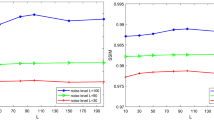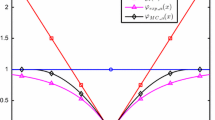Abstract
In this paper, we introduce a class of variational models for the restoration of ultrasound images corrupted by noise. The proposed models involve the convex or nonconvex total generalized variation regularization. The total generalized variation regularization ameliorates the staircasing artifacts that appear in the restored images of total variation based models. Incorporating total generalized variation regularization with nonconvexity helps preserve edges in the restored images. To realize the proposed convex model, we adopt the alternating direction method of multipliers, and the iteratively reweighted \(\ell _1\) algorithm is employed to handle the nonconvex model. These methods result in fast and efficient optimization algorithms for solving our models. Numerical experiments demonstrate that the proposed models are superior to other state-of-the-art models.












Similar content being viewed by others
References
Aubert, G., Aujol, J.F.: A variational approach to removing multiplicative noise. SIAM J. Appl. Math. 68(4), 925–946 (2008)
Aubert, G., Kornprobst, P.: Mathematical Problems in Image Processing: Partial Differential Equations and the Calculus of Variations, vol. 147. Springer, Berlin (2006)
Barcelos, C.A., Vieira, L.E.: Ultrasound speckle noise reduction via an adaptive edge-controlled variational method. In: 2014 IEEE International Conference on Systems, Man, and Cybernetics (SMC), pp. 145–151 (2014)
Besag, J.: Digital image processing: towards Bayesian image analysis. J. Appl. Stat. 16(3), 395–407 (1989)
Bredies, K., Holler, M.: A TGV regularized wavelet based zooming model. Scale Space Var. Methods Comput. Vis. 7893, 149–160 (2013)
Bredies, K., Kunisch, K., Pock, T.: Total generalized variation. SIAM J. Imaging Sci. 3(3), 492–526 (2010)
Bredies, K., Kunisch, K., Valkonen, T.: Properties of \(L^1\) -\(TGV^2\): The one-dimensional case. J. Math. Anal. Appl. 389(1), 438–454 (2013)
Candés, E.J., Wakin, M.B., Boyd, S.P.: Enhancing sparsity by reweighted \(\ell _1\) minimization. J. Fourier Anal. Appl. 14, 877–905 (2008)
Chambolle, A.: An algorithm for total variation minimization and applications. J. Math. Imaging Vis. 20, 89–97 (2004)
Chambolle, A., Lions, P.: Image recovery via total variation minimization and related problems. Numer. Math. 76(2), 167–188 (1997)
Chambolle, A., Pock, T.: A first-order primal-dual algorithm for convex problems with applications to imaging. J. Math. Imaging Vis. 40(1), 120–145 (2011)
Chan, T., Marquina, A., Mulet, P.: High-order total variation-based image restoration. SIAM J. Sci. Comput. 22(2), 503–516 (2000)
Deng, W., Yin, W.: On the global and linear convergence of the generalized alternating direction method of multipliers. J. Sci. Comput. 66, 889–916 (2016)
Douglas, J., Rachford, H.H.: On the numerical solution of heat conduction problems in two and three space variables. Trans. Am. Math. Soc. 82(2), 421–439 (1956)
Eckstein, J., Bertsekas, D.P.: On the Douglas–Rachford splitting method and the proximal point algorithm for maximal monotone operators. Math. Program. 55, 293–318 (1992)
Geman, D., Yang, C.: Nonlinear image recovery with half-quadratic regularization. IEEE Trans. Image Process. 4(7), 932–946 (1995)
Geman, S., Geman, D.: Stochastic relaxation, Gibbs distributions, and the Bayesian restoration of images. IEEE Trans. Pattern Anal. Mach. Intell. PAMI 6(6), 721–741 (1984)
Getreuer, P.: Total variation inpainting using split Bregman. Image Process. On Line 2, 147–157 (2012)
Goldstein, T., Bresson, X., Osher, S.: Geometric applications of the split Bregman method: segmentation and surface reconstruction. J. Sci. Comput. 45, 272–293 (2010)
Goldstein, T., Osher, S.: The split Bregman method for L1-regularized problems. SIAM J. Imaging Sci. 2(2), 323–343 (2009)
Jin, Z., Yang, X.: A variational model to remove the multiplicative noise in ultrasound images. J. Math. Imaging Vis. 39, 62–74 (2011)
Kang, M., Jung, M., Kang, M.: Nonconvex higher-order regularization based Rician noise removal with spatially adaptive parameters. J. Vis. Commun. Image R. 32, 180–193 (2015)
Krishnan, D., Fergus, R.: Fast image deconvolution using hyper-Laplacian priors. In: Proceedings of the Advances in Neural Information Processing Systems, pp. 1033–1041 (2009)
Krissian, K., Kikinis, R., Westin, C., Vosburgh, K.: Speckle constrained filtering of ultrasound images. IEEE Comput. Vis. Pattern Recogn. 2, 547–552 (2005)
Kuan, D.T., Sawchuk, A.A., Strand, T.C., Chavel, P.: Adaptive restoration of images with speckle. IEEE Trans. Acoust. Speech Signal Process. ASSP–35, 373–383 (1987)
Lee, J.S.: Speckle suppression and anaylsis for synthetic aperture radar. Opt. Eng. 25(5), 636–643 (1999)
Li, F., Shen, C., Fan, J., Shen, C.: Image restoration combining a total variational filter and a fourth-order filter. J. Vis. Commun. Image R. 18(4), 322–330 (2007)
Loupas, T., McDicken, W.N., Allan, P.L.: An adaptive weighted median filter for speckle suppression in medical ultrasonic images. IEEE Trans. Circuits Syst. 36(1), 129–135 (1989)
Lysaker, M., Lundervold, A., Tai, X.C.: Noise removal using fourth-order partial differential equation with application to medical magnetic resonance images in space and time. IEEE Trans. Image Process. 12(12), 1579–1590 (2003)
Nesterov, Y.: Introductory Lectures on Convex Optimization: A Basic Course, vol. 87. Kluwer, Boston (2004)
Nikolova, M., Ng, M.K., Tam, C.P.: Fast nonconvex nonsmooth minimization methods for image restoration and reconstruction. IEEE Trans. Image Process. 19(12), 3073–3088 (2010)
Nikolova, M., Ng, M.K., Zhang, S., Ching, W.: Efficient reconstruction of piecewise constant images using nonsmooth nonconvex minimization. SIAM J. Imaging Sci. 1(1), 2–25 (2008)
Nocedal, J., Wright, S.J.: Numerical Optimization. Springer, New York (2006)
Ochs, P., Dosovitskiy, A., Brox, T., Pock, T.: An iterated \(\ell _1\) algorithm for non-smooth non-convex optimization in computer vision. In: IEEE Conference on Computer Vision and Pattern Recognition (CVPR) (2013)
Ochs, P., Dosovitskiy, A., Brox, T., Pock, T.: On iteratively reweighted algorithm for nonsmooth nonconvex optimization in computer vision. SIAM J. Imaging Sci. 8(1), 331–372 (2015)
Oh, S., Woo, H., Yun, S., Kang, M.: Non-convex hybrid total variation for image denoising. J. Vis. Commun. Image R. 24(3), 332–344 (2013)
Papafitsoros, K., Schönlieb, C.B.: A combined first and second order variational approach for image restoration. J. Math. Imaging Vis. 48, 308–338 (2014)
Robini, M., Lachal, A., Magnin, I.: A stochastic continuation approach to piecewise constant reconstruction. IEEE Trans. Image Process. 16(10), 2576–2589 (2007)
Rudin, L.I., Osher, S., Fatemi, E.: Nonlinear total variation based noise removal algorithms. Phys. D Nonlinear Phenom. 60(1), 259–268 (1992)
Setzer, S., Steidl, G.: Variational methods with higher-order derivatives in image processing. In: Approximation Theory XII: San Antonio, pp. 360–386 (2008)
Setzer, S., Steidl, G., Teuber, T.: Deblurring Poissonian images by split Bregman techniques. J. Vis. Commun. Image R. 21(3), 193–199 (2010)
Shi, J., Osher, S.: A nonlinear inverse scale space method for a convex multiplicative noise model. SIAM J. Imaging Sci. 1(3), 294–321 (2008)
Steidl, G., Teuber, T.: Removing multiplicative noise by Douglas-Rachford splitting methods. J. Math. Imaging Vis. 36(2), 168–184 (2010)
Teboul, S., Blanc-Feraud, L., Aubert, G., Barlaud, M.: Variational approach for edge-preserving regularization using coupled PDEs. IEEE Trans. Image Process. 7(3), 387–397 (1998)
Vese, L., Chan, T.: Redced non-convex functional approximations for image restoration and segmentation. UCLA CAM Report 97-56 (1997)
Woo, H., Yun, S.: Proximal linearized alternating direction method for multiplicative denoising. SIAM J. Sci. Comput. 35(2), B336–B358 (2013)
Yang, J., Zhang, Y.: Alternating direction algorithms for \(\ell _1\) problems in compressive sensing. SIAM J. Sci. Comput 33(1), 250–278 (2011)
Acknowledgements
Myeongmin Kang was supported by the NRF (2016R1C1B1009808). Myungjoo Kang was supported by the NRF (2014R1A2A1A10050531, 2015R1A5A1009350), MOTIE (10048720) and IITP-MSIP (B0717-16-0107). Miyoun Jung was supported by the Hankuk University of Foreign Studies Research Fund and NRF (2013R1A1A3010416).
Author information
Authors and Affiliations
Corresponding author
Appendix: The Proof of Theorem 3
Appendix: The Proof of Theorem 3
Proof
For any fixed \(x\in \varOmega ,\) we can deduce from the inequality of arithmetic-geometric mean that for \(u > 0\),
It follows from the above inequality that
i.e., E(u) is bounded below. Hence, we can choose a minimizing sequence \(\{u^n\}\in L^2(\varOmega )\) for problem (12), and the sequence \(\{TGV^2_\alpha (u^n)\}\) is also bounded.
In addition, from the Poincar\(\acute{e}\) inequality of \(TGV^2_\alpha \), we can obtain that
where \(P : L^2(\varOmega ) \rightarrow \ker (TGV_\alpha ^2)\) is a linear projection. It follows that \(u^n - Pu^n\) is bounded in \(L^2(\varOmega )\) for each n.
We can also easily deduce that for \(u > 0\),
where c is a positive constant that is independent of n. Since \(\{u^n\}\) is a minimizing sequence of problem (12), \(\Vert Pu^n\Vert _2\) is bounded from the above inequalities.
Then, from the following inequalities,
we can conclude that \(\{u^n\}\) is bounded in \(L^2(\varOmega )\). Therefore, there exist a subsequence \(\{u^{n_k}\}\) and \(u^*\in L^2(\varOmega )\) such that the subsequence converges weakly to \(u^*\). Since \(u^n > 0\) and \(E(u^*)\) must be bounded, \(u^* > 0\) and \(u^*\in S(\varOmega )\).
Because \(TGV^2_\alpha \) is lower semicontinuous, E(u) is also lower semicontinuous. By applying Fatou’s Lemma, we have
which implies that \(u^*\) is a solution of problem (12).
If we let \(p(t) = \frac{(f(x) -t)^2}{t}\) for any fixed \(x\in \varOmega \), then its second derivative is given by \(p''(t) = \frac{2f(x)^2}{t^3}\) and thus \(p''(t) > 0\) for any \(t > 0\). Hence, p is a strictly convex function when \(t > 0\). Therefore, problem (12) has a unique minimizer. \(\square \)
Rights and permissions
About this article
Cite this article
Kang, M., Kang, M. & Jung, M. Total Generalized Variation Based Denoising Models for Ultrasound Images. J Sci Comput 72, 172–197 (2017). https://doi.org/10.1007/s10915-017-0357-3
Received:
Revised:
Accepted:
Published:
Issue Date:
DOI: https://doi.org/10.1007/s10915-017-0357-3




